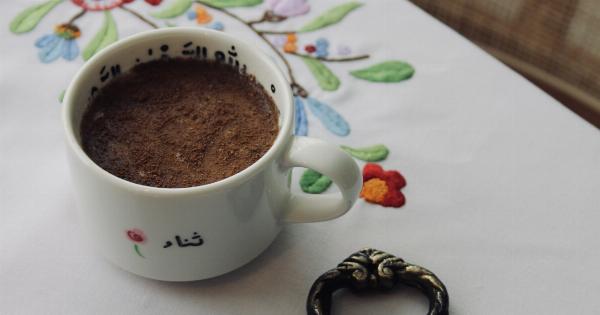Everyone loves chocolate. It’s sweet, it’s indulgent, and it’s the perfect treat for any occasion. Whether it’s a birthday celebration or a simple pick-me-up, chocolate has been a go-to option for centuries.
However, as we delve deeper into the 21st century, we must face the reality that chocolate may soon become a thing of the past. This once-beloved confection is facing numerous challenges that threaten its existence. From environmental issues to health concerns, the fate of chocolate hangs in the balance.
In this article, we will explore the reasons behind this alarming statement and why the future may not be as sweet as we once thought.
1. Climate Change and Cacao Production
Climate change is undeniably one of the most pressing issues of our time. Rising temperatures and changing weather patterns have a significant impact on various industries, including chocolate production.
The cacao tree, which is the source of chocolate, is highly sensitive to temperature and humidity. It thrives in specific regions of the world, such as West Africa and Latin America, where the conditions are ideal.
Unfortunately, climate change is causing havoc in these regions. Unpredictable weather events disrupt the delicate balance required for cacao cultivation.
Droughts, floods, and heatwaves have become more frequent, making it increasingly challenging for farmers to grow cacao. As a result, the overall production and quality of chocolate are declining.
2. Deforestation for Cacao Plantations
Another serious issue associated with chocolate production is deforestation. Cacao plantations require vast amounts of land to meet the ever-growing demand for chocolate.
This demand, coupled with the economic incentives for farmers, leads to the clearing of forests to make way for cacao trees.
Deforestation not only destroys unique ecosystems but also contributes to climate change. Trees act as natural carbon sinks, absorbing carbon dioxide from the atmosphere.
When trees are cut down, this stored carbon is released, intensifying the greenhouse effect. Furthermore, deforestation threatens the habitat of numerous species, including endangered animals like orangutans and jaguars.
3. Child Labor and Exploitation
The dark side of the chocolate industry involves child labor and exploitation. Many cacao-producing regions, particularly in West Africa, rely on cheap labor, often sourced from vulnerable communities.
Children, some as young as 6 years old, are forced to work long hours in hazardous conditions to meet the growing global demand for chocolate.
This ethical issue has gained international attention and sparked demand for fair-trade and ethically sourced chocolate. Consumers are increasingly conscious of the environmental and social impact of their purchases.
However, despite efforts to combat child labor, the problem persists, endangering the future of chocolate.
4. Rising Health Awareness
As society becomes more health-conscious, the impact of chocolate on our well-being is scrutinized. While chocolate can provide pleasure and momentary happiness, its high fat and sugar content pose significant health risks.
Overconsumption of chocolate has been linked to obesity, heart disease, and other health problems.
Furthermore, alternative healthier snack options are gaining popularity. From fruit bars to protein-packed energy balls, consumers are shifting towards products that offer nutritional benefits without compromising on taste.
This shift in preferences indicates a diminishing demand for traditional chocolate products.
5. Technological Advancements and Alternative Options
The digital era has brought about rapid advancements in food technology, including the development of alternative options to chocolate.
With innovations such as 3D printing and plant-based ingredients, food scientists are creating new and exciting products that mimic the taste and texture of chocolate without actually containing cocoa.
These alternatives not only cater to health-conscious consumers but also address the environmental and ethical concerns associated with chocolate production.
As technology continues to evolve, it is highly likely that these alternative options will become more mainstream, further diminishing the demand for traditional chocolate.
6. Changing Consumer Preferences
As generations change, so do their preferences. The millennial and Gen Z populations, who will soon dominate the consumer market, have different priorities and tastes compared to previous generations.
These younger consumers are more inclined towards sustainable and ethical choices. They value transparency, impact, and uniqueness in their purchasing decisions.
These shifting consumer preferences have already influenced various industries, including fashion, where sustainable and eco-friendly brands have gained popularity.
It is reasonable to assume that the chocolate industry will face a similar fate, as younger generations become more aware of the impact of their choices.
7. Rising Cost of Production
The challenges faced by the chocolate industry, from climate change to deforestation, lead to increased production costs.
Farmers have to adapt to changing conditions, invest in sustainable practices, and tackle pests and diseases that thrive in the warmer climate. All these factors contribute to higher expenses throughout the chocolate supply chain.
As production costs increase, so does the retail price of chocolate. Consumers are becoming more price-sensitive, and the rising cost may deter them from purchasing chocolate regularly.
This could create a vicious cycle: reduced demand leads to lower sales, which in turn leads to higher prices, further hampering the industry’s future.
8. Shifting Cultural Norms
Chocolate has long been embedded in different cultures and traditions around the world. However, as societies globalize and cultures blend, preferences are evolving.
Traditional chocolate may find itself competing with new flavors and trends that capture the interest of consumers.
In some cases, local delicacies and desserts have gained popularity, pushing chocolate aside. For instance, matcha-flavored snacks have become a sensation in various parts of the world, replacing the classic chocolate options.
This cultural shift, driven by globalization and social media, further contributes to the uncertain future of chocolate.
9. The Rise of Artificial Sweeteners and Sugar-Free Options
Artificial sweeteners and sugar-free products are on the rise, appealing to health-conscious individuals and those with dietary restrictions.
These alternatives offer the sweetness without the negative health implications associated with sugar consumption.
Chocolate companies have started exploring these options to cater to the changing taste preferences of consumers. Sugar-free and low-calorie chocolates have entered the market, providing guilt-free indulgence.
While these products do not replicate the exact taste of traditional chocolate, they offer a viable alternative for those looking for healthier options.
10. Limited Availability and Rarity
If the challenges mentioned above continue to persist, the availability of chocolate may become limited in the future. Reduced production due to climate change and unsustainable farming practices could result in scarcity.
When a beloved product becomes scarce, its value increases, making it less accessible to the average consumer.
The rarity of chocolate could lead to a decline in its popularity. As consumers seek new and easily available alternatives, chocolate may lose its long-held position as the go-to treat.
Conclusion
While it may be disheartening to imagine a world without chocolate, it is crucial to recognize the threats it faces.
The combination of climate change, deforestation, health concerns, and shifting consumer preferences paints a grim picture for the future of this beloved confection.
While it is not yet time to say goodbye to chocolate entirely, it is evident that significant changes are required to sustain its existence. From sustainable farming practices to ethical sourcing, the chocolate industry must adapt to survive.
Only by addressing these challenges head-on can we hope to keep chocolate from becoming a thing of the past.






























